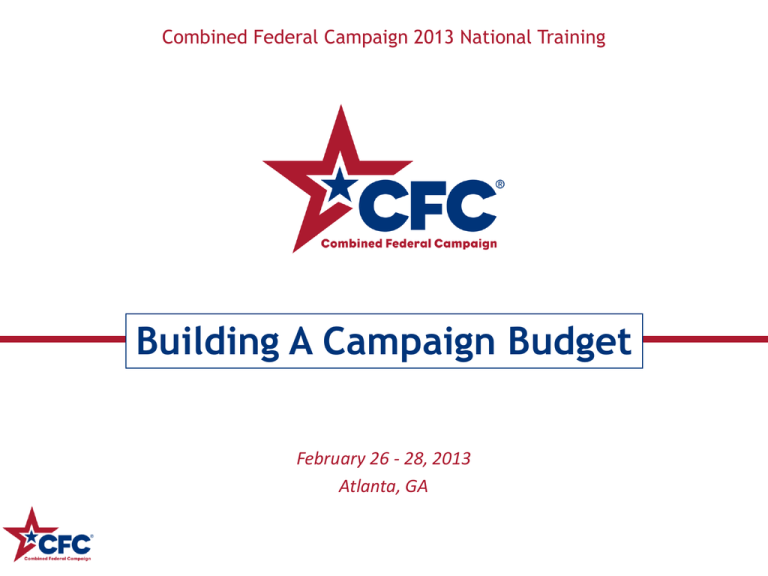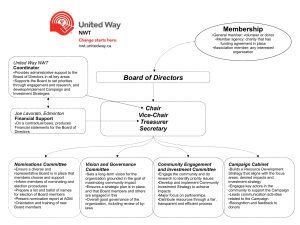9 - Building a Campaign Budget presentation 1-18-13
advertisement

Combined Federal Campaign 2013 National Training Building A Campaign Budget February 26 - 28, 2013 Atlanta, GA Session Objectives • Maximize donor funds going to charities by keeping expenses as low as possible • Understand importance of a sound Financial Management Plan • Establish detailed budget categories in the contract solicitation • Negotiate budget amounts annually • Conduct monthly expense reviews • Verify final expense recovery reimbursement 2 Presented by • Sally Good-Burton, Office of Information Services Group Director, Centers for Medicare and Medicaid Services, U.S. Dept Health and Human Services, and LFCC Chair, Chesapeake Bay Area CFC sally.good-burton@cbacfc.org • William Henrikson, Chief Financial Officer, Volpe National Transportation Systems Center, U.S. Dept of Transportation and LFCC Chair, Eastern Massachusetts CFC william.henrikson@dot.gov 3 Chesapeake Bay Area CFC • Third largest CFC in 2011; over 4,000 charities participated • Functions under direction of the Baltimore Federal Executive Board • Campaign area includes Baltimore city and 16 counties in Maryland and Virginia • Includes 135 Federal agencies with 91,391 employees • 2011 CFC raised a record $6.8M (19% participation rate; $390 average pledge) • Won National Performance Award for $1M+ campaigns in 2011 for 11.3% increase over 2010 • Utilized 7 Loaned Executives from 4 Federal agencies 4 Eastern Massachusetts CFC • Created in 2004 – 3 CFCs merged • Area includes city of Boston (Suffolk County) and surrounding counties • ~150 federal agencies with approximately 30,000 employees • 2011 CFC raised $1.99 (24% participation rate, $278.35 average pledge • 10 Loaned Executives work directly with PCFO • Participant in the New England Region Local Eligibility Application Process. Shared local federation application review process with other New England PCFOs. 5 Importance of detailed financial management plan and budget • The LFCC is responsible for overseeing a campaign in a given area in accordance with OPM direction; fiduciary responsibilities are paramount! • Must ensure that all donor contributions are safeguarded and used as intended by the donor • Financial management plan presents sound fiscal approach and describes internal controls – Internal controls provide reasonable assurance that the following objectives are being achieved: • effectiveness and efficiency of operations, • reliability of financial reporting, and • compliance with applicable laws and regulations. • Currently, expenses are recovered from donor contributions; campaigns must strive to minimize costs and maximize funds going directly to designated charities • Budget must be based on projected expenses – not based on a percentage of funds raised in the campaign • Approve only necessary, legitimate campaign expenses 6 Financial Management Plan Components • Describe internal controls designed to provide reasonable assurances that fiduciary responsibilities of § 5 CFR 950.105 will be achieved U.S. Government Accountability Office (GAO)’s Five Standards for Internal Control • Control Environment • Risk Assessment • Control Activities • Information and Communications • Monitoring • Specifically address the system for reconciliation of original pledge amounts with final distribution of funds • Identify checks and balances in place to ensure accountability and integrity of financial system 7 Campaign Budget Justification • Projected expenses for upcoming campaign(s) with narrative justification explaining rationale and/or formulas used in calculating major cost categories • Expenses must be presented at a sufficient level of detail to enable understanding of all necessary costs to run a campaign • LFCC approval required annually for campaign budget; collaborative approach may provide greatest efficiencies 8 Sample Campaign Budget Categories • Total Payroll-Related Expenses – Salaries – by individual position, full-time and part-time and all temporary positions….direct and indirect – Employee benefits – direct and indirect – Payroll Taxes – direct and indirect • Other Campaign Staff Expenses – Local transportation and parking – Staff development • Volunteer Development – Local transportation and parking – Professional development 9 Sample Campaign Budget Categories • Campaign Processing Expenses – – – – – – – – Third party processor expenses (if used) Pledge processing system Electronic pledging system Telecommunications (voice and data) Postage and Shipping Warehouse Office supplies Website • Design and development • Maintenance and Update 10 Sample Campaign Budget Categories • Total Marketing Expenses – Printing – list individual items and estimates for each item Examples: • Paper pledge forms • Paper charity list or Giving Guide • Brochures, posters, postcards, banners • Volunteer training and support materials – Storage and shipping materials to agencies – Video / Media aids – Donor recognition and incentive gifts – Campaign and special events – list individually (campaign or agency kick-off; mid-campaign rally; recognition events) • Reminder: Campaign cannot pay for food or entertainment at these events 11 Sample Campaign Budget Categories • Other Expenses – Occupancy (rent, utilities; office amenities) – Depreciation (office and computer equipment, furniture, fixtures) – Annual Audit - An assessment by an independent certified public accountant using generally accepted auditing standards (GAAS) and following the Agreed-Upon Procedures (AUP) provided by OPM 12 Projected Revenue Conservatively estimate amount expected to be raised • Based on Federal employee population (current and projected) • Performing at campaign average participation rate and average gift – adjusted for future expectation Example: 50,000 employees – 25% participation & $300 average gift = $3,750,000 Shrinkage: The difference between the amount pledged and the amount actually collected. Used in adjusting distribution payment; not part of budget 13 Campaign Overhead Rate Total Estimated Expenses per year Divided by Campaign Projection Revenue per year Equals Percent of CFC Expenses to Campaign 14 Monthly Budget and Expense Reports • After LFCC approval of campaign budget, the PCFO submits detailed monthly expense reports to LFCC showing all expense transactions, accompanied by copy of invoices/receipts, by 15th of following month. • An LFCC member reviews materials for accuracy and completeness; meets with PCFO CFO staff to discuss any questions or missing receipts • Summary financial reports presented regularly to the full LFCC • Summary and detailed financial materials maintained in LFCC office for 3 years after close of campaign • Budget and expense information must be made available to the public upon request 15 Example of Summary Report 16 Example of Detailed Report PCFO Name Transaction Journal 2012 Campaign For the Period March 1, 2012 - November 30, 2012 Date Transaction Journal Reference account number and description Payroll Description of item Journal Entry Accounts Payable Debit Amount Credit Amount $ $ Project ID campaign year account number and description account number and description 17 PCFO Expense Recovery § 950.106 “The PCFO shall recover from the gross receipts of the campaign its expenses, approved by the LFCC, reflecting the actual costs of administering the local campaign.” • • Final expense amount equals cumulative LFCCapproved expenses for a campaign Monitoring/reviewing /approving expenses and receipts on a monthly basis supports a timely and smooth LFCC approval process! Reminders: • The amount to be recovered cannot exceed 110 percent of estimated budget (unless approved by OPM Director) • Expenses shared proportionately by all recipient organizations reflecting their share of gross receipts 18 Recap • LFCC responsible for ensuring sound financial management of campaigns • Budgets need to be detailed to allow for understanding of costs and cost drivers • Budgets must be negotiated annually • LFCCs should approve only necessary, legitimate campaign expenses • Conduct monthly reviews of actuals versus budget • Verify final expense recovery reimbursement 19 Any Questions? 20








